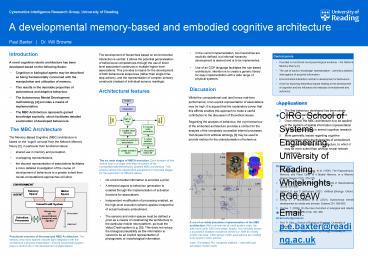A developmental memorybased and embodied cognitive architecture - PowerPoint PPT Presentation
1 / 1
Title:
A developmental memorybased and embodied cognitive architecture
Description:
Cognition in biological agents may be described as being fundamentally concerned ... the discreet representation of associations facilitates a more detailed ... – PowerPoint PPT presentation
Number of Views:41
Avg rating:3.0/5.0
Title: A developmental memorybased and embodied cognitive architecture
1
A developmental memory-based and embodied
cognitive architecture
- Introduction
- A novel cognitive robotic architecture has been
developed based on the following thesis - Cognition in biological agents may be described
as being fundamentally concerned with the
manipulation and utilisation of memory. - This results in the desirable properties of
autonomous and adaptive behaviour. - The Autonomous Mental Development methodology 4
provides a means of implementation. - The MBC Architecture represents gained knowledge
explicitly, which facilitates detailed
examination of developed behaviours. - The MBC Architecture
- The Memory-Based Cognitive (MBC) architecture is
based on the cognit concept from the Network
Memory theory 2, in particular their functional
nature - shared use in memory and perception,
- overlapping representations,
- the discreet representation of associations
facilitates a more detailed investigation of the
course of development of behaviours to a greater
extent than neural-computational approaches will
allow.
- The development of hierarchies based on
environmental interaction is central it allows
the potential generalisation of behavioural
competencies through the use of lower level
association constructs in multiple higher level
associations. This provides a means for the
development of both behavioural sequences (rather
than single time-step actions), and the
representation of complex sensory constructs
(instead of individual sensory readings). - Architectural features
- No environmental information is encoded a priori.
- A temporal aspect to behaviour generation is
enabled through the implementation of activation
functions for associations. - Independent modification of processing enabled,
as the high-level execution scheme applies
irrespective of actual hardware embodiment.
- In the current implementation, two hierarchies
are explicitly defined, but informal hierarchy
development is desired and is to be implemented. - Use of an OOP language facilitates the rule-based
architecture intention is to create a generic
library for easy implementation with a wide range
of physical systems. - Discussion
- Whilst the computational cost (and hence
real-time performance) of an explicit
representation of associations may be high, it is
argued that the explanatory power that this
affords enables this approach to make a useful
contribution to the discussion of theoretical
issues. - Regarding the analysis of behaviour, the overt
behaviour of the embodied architecture provides a
context for the analysis of the completely
accessible internal processes. Techniques from
artificial ethology 3 may be used to provide
metrics for the characterisation of behaviour.
- Applications
- The first behaviour developed has been simple
obstacle avoidance in an enclosed environment. - Once refined, the MBC architecture is to be
applied to the problem of spatial information
representation 1 an open question in animal
cognition research. - More generally, issues regarding cognitive
development within the constraints of embodiment
may be explored using this architecture, to which
it may be more suited than artificial neural
network approaches.































